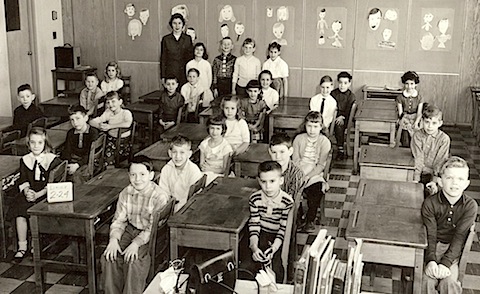In a cramped elementary conference room a young second grade teacher, from one of the finest colleges on the East Coast, sits with a mother and father, the principal and several other specialists, delivering the devastating news with as much care as possible.
“I’m sorry Mr. and Mrs. Smith, this must be very difficult for you. However, it’s clear from testing, your son has a very severe communication disorder. He will probably never learn to read or write. That will make math difficult, if not impossible. If he gets along with his peers, it is possible he could be on a vocational track through High School. But you must prepare yourself. He won’t graduate with the rest of his class. He won’t get a standard diploma. He could get a certificate stating he put in three or more years at high school, but that’s all. It will be very difficult. But if we work hard, and we are lucky, it is possible he could grow up to be something like a plumber’s assistant or something–just not the guy who fills out the paperwork.”
That was 1968, and my diagnosis as a 2nd grader — Dyslexia.
Two graduate schools later, having worked paying my mortgage (for three years sun-up to sun-down) writing for CNN, having created television shows and designed the world’s largest television newsgathering network, having managed companies and 300 million dollar budgets, having lived my life with a big (backwards) scarlet “D” on my shoulder, I really would like to go back in time to 1968, find that teacher and slap her. (That is, if I were the slapping sort, which I am not.)
But she’s is more than 70-years old now and no longer relevant. What is a worry is the 23-year old version of her, now in 2010. What are they saying to parents about children with communications disorders? Even communication disorders which seem so overwhelming such as Autism.
Dyslexia was the “Autism” of its day, in 1968–pervasive, disabling, not understood. A real spear in the side of the then current educational paradigm. But just as it will with Autism, things changed. Our medical understanding of Dyslexia grew, technology advanced, and our educational approach adjusted.

WHAT SHE DIDN’T KNOW BACK THEN, ABOUT THE FUTURE:
1968-69
- I was enrolled in some of the earliest pilots of reading programs which later became elements of the Edmark reading program
- My mother demanded I remain in general education, making me one of the first “inclusive” special education students
- Daily tutoring after school for 3 hours
- Visiting every medical specialist in existence
- Advent of commercially available portable cassette tape recorders and players
1970s
- Advent of Educational Television (Sesame Street, Electric Company)
- Increased understanding of Dyslexia in medicine
- Increased understanding of psychology’s role in education
- Increased understanding of Dyslexia in education
- Advent of home video players and educational videos
- Advent of sony walkman cassette tape players
- Advent of interchangeable cassettes for white-out and ribbon on electric typewriters
- Advent of spell check prediction on electric typewriters
- International direct-dial-up telephone communication
1980-83
- First “luggable” IBM PCs with amber screens and rudimentary word processing
- Computer daisy-wheel printers, with uninterrupted paper feeds.
- Office newsrooms completely computerized with global mainframe access, word processing & electronic messaging
- Micro audio recorders
And on and on (over the course of 15 years)…allowing my first job out of Georgetown’s Graduate School of Foreign Service to be with NBC in their Cairo, Egypt bureau.
My 2nd grade teacher’s world of type-written stamp-and-envelope post for business communications and the very rudimentary direct instruction and rote transcription that defined education, was quickly snuffed out by advances in technology, education, psychology, medicine and changes in the the type of work needed in an economy ever morphing into the future.
WHAT WE DON’T KNOW NOW, ABOUT THE FUTURE OF THE NEXT FIFTEEN YEARS:
In advances in communications technologies??
In advances in educational practice??
In advances in medical understanding of communication disorders such as Autism??
In advances and changes in the job skills demanded by the future economy??
In advances in the integration of these four trends with one another??
- Technology & Education
- Education & Communication
- Medicine & Technology
- Medicine & Education
The answer, WE DON’T KNOW. Heck even the best minds studying the future barely see 1 to 2 YEARS out.
TEACHING FOR THE FUTURE:
We need teachers who are surfing these trends rather than handing out death sentences based on the static information of the day.
I’m not talking about tilting windmills. I know many special needs students will never have “normal” careers. But there’s more to life in the next 15 to 30 years for heavily impacted (read “non-verbal/ID”) people than institutionalization. There are real opportunities for a fulfilling life of happiness and friendship.
Technology and communication is becoming much more visual and personal than ever before. People’s attitudes toward ID and Autism is becoming much more accepting. People are figuring out how to work with these types of folks more and more. These trends are going to continue and make things easier for those with communications disorders — no matter how severe. I’m not saying many will be able to completely overcome their disabilities using technology, but the trends toward the future are promising to have a very positive impact on their ability to function.
We should be looking to sculpt an education and trajectory for these students which will allow them to keep as many options open as possible for a future which is morphing in their direction.
We need special educators who see this.
SPECIAL EDUCATION DEATH SENTENCE:
So the next time you are considering giving a death sentence to some kid…
Telling his parents what’s going to happen to a student 15 years from now…
Remember, they get to live through the next 15 years. You’re just guessing.
